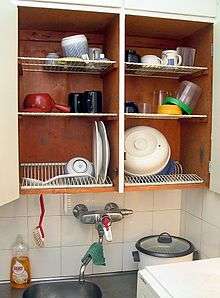Dish drying cabinet

The dish drying cabinet was originally patented in the USA by Louise R. Krause (US patent 1860617) in May 1932.
Maiju Gebhard independently developed a dish drying cabinet in Finland based on research she and others carried out from 1944 to 1945 in the Finnish Work Efficiency Institute with the goal of reducing the work involved in dishwashing by making the entire manual drying phase unnecessary. The Finnish Invention Foundation has named it one of the most important Finnish inventions of the millennium.
The inspiration for the dish drying cabinet was a Swedish dish draining holder, which was kept on the counter. Gebhard noticed that most families never used the holder, but instead dried the washed dishes by hand and put them directly into a cabinet or cupboard. Gebhard's idea was to put the dish draining holder in the cabinet above the dish washing table (sideboard or counter top), so the dishes could drain dry in place. This way, an entire phase of normal household upkeep could be skipped. According to Gebhard's calculations, the average housewife spent almost 30,000 hours of her life washing and drying dishes.[1]
Enso-Gutzeit started producing dish draining closets in 1948. Since 1954, dish draining closets were made of plastic-coated steel wire to help keep them clean. The measurements for the closets were standardised in 1982.
The cabinets have an open bottom that allows for the water to drain directly into the sink below.